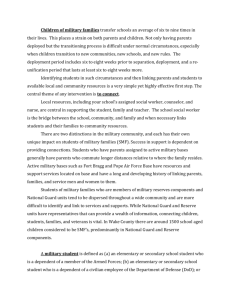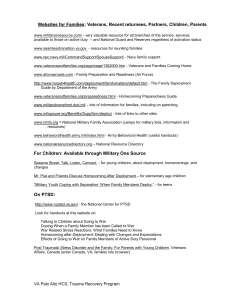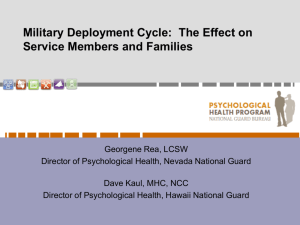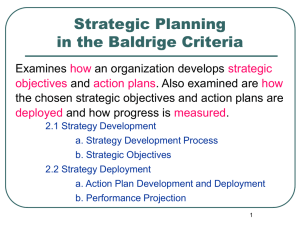Discuss
advertisement
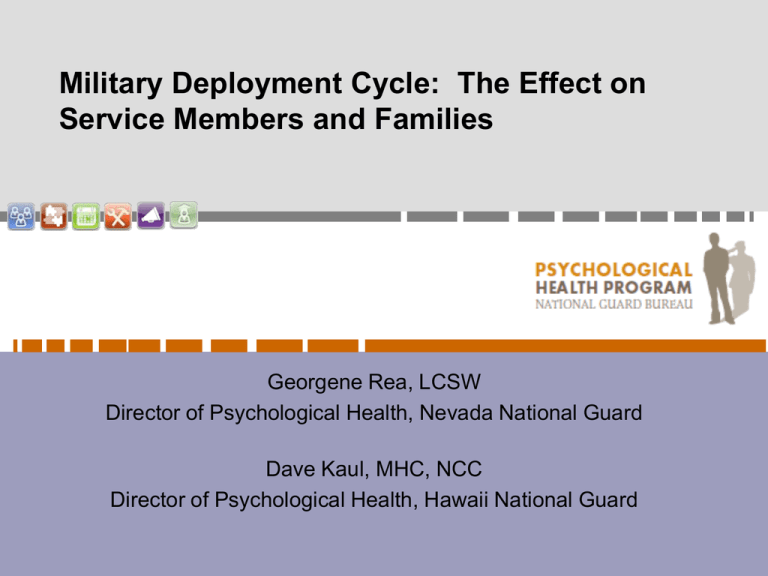
Military Deployment Cycle: The Effect on Service Members and Families Georgene Rea, LCSW Director of Psychological Health, Nevada National Guard Dave Kaul, MHC, NCC Director of Psychological Health, Hawaii National Guard Military Deployment Cycle: The Effect on Service Members and Families The goals of this presentation are: • To introduce you to general information regarding the deployment cycle and how it impacts both the Service Members and family units. • To gain a better understanding of common reactions to war and reintegration/readjustment • To provide you with an additional tool to assist in safely responding and interacting with a member of the military community who might be experiencing an emotional crisis Ground Rules • This is not a political debate • Questions are encouraged for group discussion • Please be respectful of others • If the dialogue or material become too troubling, feel free to leave the room until you feel comfortable enough to return http://youtu.be/CbILpVzT_J8 Video: U.S. Military Tribute – I’m Already There Learning Objectives • Discuss demographic and risk characteristics of military families • Describe general and deployment related stressors for military families and the stages of the deployment cycle • Gain a basic understanding of the readjustment behaviors exhibited by returning veterans Bringing attention 1% of American men and women are fighting our wars – willingly taking on the ultimate responsibility of protecting our nation. They do not make these sacrifices alone – when our troops are called to action, so are their families/friends/support systems. • Since 2001, there have been over 1.6 million deployments in support of Operation Iraqi Freedom (OIF) and Operation Enduring Freedom (OEF). • • • 1/3 have served at least two tours in combat zones 70,000 have been deployed at least five times To date, approximately 2 million children have experienced a parental deployment in support of OEF/OIF Military Culture Active Duty vs. Guard/Reserve Units Active Duty Guard/Reserve Units • Units are based at major military installations. • Units are small & based in local communities. • • Part-time citizen soldiers, often working with local police, fire, and EMS. Full-time soldiers who expect to be deployed • • Families are left at their post where a variety of support is in place both on-post & in communities. Families may be left in a town with little or no support services. • Mostly support units (transport, MP, etc) • Live on-post or nearby; other family support • Likely to work within local communities • Less need to relocate when deployed • Can’t relocate easily when activated • Access to a variety of health, welfare, & educational services • Lack of military related health services • Need to make use of family or local supports (church, etc.) though FRG’s are very helpful • Support groups in-place through soldier’s unit The Service Member Experience OIF / OEF • not homogenous---heterogeneous • Active duty • 40% Reservists/National Guard • joined for variety of reasons • likely did not expect to be deployed • Large number of civilian contractors • wide age range: 18-60+ • married • parenting/grand-parenting job/career • financial responsibilities (e.g. mortgage, family) • Multiple deployments with unknown duration are typical • instant communication (Skype, Facebook, email) • Unconventional warfare (no front line, IEDs, suicide bombers) • wounded/killed ratio 15:1 Deployed Military – current statistics • • • • Men = 90% Women = 10% Married = 53% with children = 68% without children = 32% Single = 47% with children = 13% without children = 87% Center for Deployment Psychology and Army OneSource The Deployment Cycle Military life has unique stresses • Pre-deployment stressors Leaving loved ones behind Fear of physical danger, injury, death • Deployment stressors Adjusting to a new place or foreign country Reintegration after returning home • Being in a war zone Harsh living conditions Excessive heat, cold, noise Constant risk of injury and death Death or injury of fellow soldiers or civilians National Guard - Managing PTSD and Other Combat-Related Stress Reactions, 2010 Cycle of Deployment Stage 1: Anticipation of Deployment Pre-deployment Phase • Timeframe: When family members receive orders • Increased feeling of stress in home • Reality of change ahead is “sinking in” • Denial & anticipation of loss • Focus is on completing family pre-deployment activity checklist • Members may feel more emotional • In case of multiple deployments . . . new cycle may begin before family has had time to renegotiate shared vision from previous deployment Stage 2: Detachment & Withdrawal Pre-deployment Phase • Timeframe: Last week before service member leaves • Service member is focused on preparing for mission and may distance self from family • Anger, arguments may occur as family prepares to protect themselves from “hurt” of separation • Communication may be difficult • In preparation for loss, family may begin to act like the service member is already gone • Multiple deployments can result in need to repeatedly create distance; to feel “numb” and avoid emotional connection Stage 3: Emotional Disorganization Deployment Phase • Timeframe: 1-6 weeks into deployment • Life without the service member may initially feel overwhelming • Routines change, responsibilities may be added • Kids may feel . . . Numb and not interested in doing much More irritable than usual Have difficulty concentrating – particularly at school Wish things would go back to “normal” Surprised because things seem to be moving more smoothly now that the service member is gone Stage 4: Recovery & Stabilization Deployment Phase • Timeframe: Usually between weeks 3 and 5 after deployment • Family finally starts to settle into routine of life without the service member • It is not uncommon for the spouse to experience: Independence Self-growth Financial Problems Loss of sleep, appetite changes Being busier than usual Increased crying, depression, anger Increased loneliness and anxiety Stage 4: Recovery & Stabilization Deployment Phase – Children & Adolescents • • • • • • • Infants to School-Aged Children Tantrums Toileting accidents Separation anxiety Aggression Behavioral changes at home/school Physical/somatic complaints Fear of abandonment Coping with changes can be positive: • • May enjoy newfound responsibility • Sense of independence Relief that family is functioning well • • • • • • Teenagers Angry, moody Poor school performance, grades Worry about deployed parent Caretaker of stateside parent Drug/alcohol use Withdrawal Stage 5: Anticipation of Return Deployment Phase • Timeframe: About 6 weeks before the service member returns • Homecoming is coming! • Family is happy, excited, and feeling a boost of energy • Trying to make everything “perfect” for the return • Sense of relief that the service member will be home, combined with worries about whether or not they will be the same • If the service member came home on leave at some point during deployment, that experience may be what family members expect: Positive Leave Experience = Positive Homecoming Challenging Leave Experience = Challenging Homecoming Homecoming = Honeymoon period Stage 6: Return, Adjustment & Renegotiation Post-deployment Phase • Timeframe: About 6 weeks after the service member returns, after initial joy and relief have diminished • During time of separation the service member and all family members have changed • Changes may hold pleasant surprises or may cause conflict • Family members may feel overwhelmed by the service member attempts to get to know everyone again • Everyone needs space and time to readjust • Entire family must begin to renegotiate how household will look now that everyone is together again Service Members and Families – video profile Stage 7: Reintegration & Stabilization Post-deployment Phase • Timeframe: Up to 6 months (and beyond) after the service member returns • Family continues to adjust to having the service member home • A “new normal” is established regarding routines and expectations • Members may begin to feel secure, relaxed, and comfortable with one another again • If readjustment challenges resurface, support is important Why do some Service Members have difficulties readjusting after deployment? Traumatic Events in Combat • • • • • • • • • • Taken prisoners of war Responsible for the care of enemy prisoners Involved in cleanup of war zones, handling dead bodies Sexually assaulted or harassed during active duty Witness to or victims of injuries during training, friendly fire Exposed to terrorist attacks Involved in peacekeeping missions Exposed to chemical, nuclear, or biological weapons Death or maiming of women and children Killing someone up close National Guard - Managing PTSD and Other Combat-Related Stress Reactions, 2010 Realities of Combat • • • • • • • • • • Fear in combat is universal Unit members will be injured and killed There will be communication breakdowns Leadership failures will be perceived Combat impacts every soldier mentally and emotionally Combat has lasting mental health effects Soldiers are afraid to admit that they have a mental health problem Deployments place a tremendous strain upon families Combat environment is harsh and demanding Combat poses moral/ethical challenges WRAIR Land Combat Study Team http://youtu.be/XzbpW5NMfls Battlemind Training • Battlemind skills helped the Service Member survive in combat, but may cause him/her problems if not adapted after returning home • • • • • • • • • • Buddies (cohesion) Accountability Targeted Aggression Tactical Awareness Lethally Armed Emotional Control Mission OPSEC Individual Responsibility Non-Defensive Driving Discipline and Ordering vs. vs. vs. vs. vs. vs. vs. vs. vs. vs. Withdrawal Controlling Inappropriate Aggression Hypervigilance “Locked and Loaded” at Home Anger/Detachment Secretiveness Guilt Aggressive Driving Conflict Deployment vs. Post-deployment stressors Service Member mindset when deployed • • • • • • • • Stay focused on mission /nothing else matters Truly life or death / always on the edge Constant adrenaline “rush” Black or white / all or nothing Sense of purpose, invincibility Only trust battle buddies /others are threat Need to control environment Real problems and needs exist in Iraq Adapted from briefing by COL Kevin Gerdes, May 2008 Mindset of Service Members returning home • • • • • • • • Life is now unfocused and complex No longer on the verge of life or death What can replace the “high” of war? Things aren’t clear cut No sense of purpose, nothing matters Can’t trust anybody Can’t be in control of surroundings Problems at home pale in comparison to those in Iraq Adapted from briefing by COL Kevin Gerdes, May 2008 Other Post-Deployment Reactions • Combat Stress: Natural result of heavy mental and emotional work when facing danger in tough conditions; physical symptoms (headaches, racing heart, fatigue, anger) generally gets better with rest and replenishment • Post-Traumatic Stress Disorder: Possible response when deployment has occurred to war zone, natural disaster site, or urban riot location: physical, mental, and emotional symptoms that require professional assistance • Secondary Traumatic Stress: Possibly experienced by family members upon return of soldier; stress resulting from helping or wanting to help a suffering or traumatized person How is this information relevant to my job as a CIT officer? 911 – What is your emergency? Identified problems leading to calls to law enforcement: • • • • • • Viewing internet pornography and internet sex chat is becoming a norm for deployment – increase in stateside sexually based offenses There is a high rate of infidelity among soldiers and spouses during deployments – resulting in conflict upon reunification (DV) Illegal/prescription drugs and alcohol are prevalent and are used as common coping mechanism by soldiers (deployed and at home) and by their spouses (buying pills off the street) Suicide (ideations, attempts) There is a high incidence of rape and sexual molestation of deployed female soldiers Home is no longer viewed as a safe place to live - many now carry weapons when at home 911 – What is your emergency? • • • • There is a statistically verifiable increase in domestic violence and child abuse among military families. Child abuse increases as the stressors increase in the life of the non-deployed spouse While deployed, many soldiers are constantly sleep deprived and share each others medications (i.e. Ambien). Hooked on Energy Drinks. Service Members may pursue activities which replicate the adrenaline rush of combat (increase in cocaine use upon returning home, extreme driving) With increased monetary incentives and a lowering of recruitment standards the quality of the troops has been increasingly lowered: no GED necessary, accepting recruits with DSM-IV diagnosable conditions and on medications, increase of gangs. Did you know?? 18.5% of veterans returning from Afghanistan and Iraq meet the criteria for Posttraumatic Stress Disorder (PTSD) and/or major depressive disorder. 19.5% report traumatic brain injuries (TBI) such as concussions during deployment. 79% of those with TBI met the criteria for alcohol abuse; 37% met the criteria for drug abuse. Substance abuse represents one of the leading causes of medical leave for military personnel, accounting for approximately 400,000 medical encounters and approximately 75,000 days of enforced bed rest each year. 30,000 suicides are committed each year on average, more than 20% are veterans. On average, a military veteran commits suicide every 24 hours. The unemployment rate of post 9-11 veterans is 10.4%, compared to a non-veteran rate of 9%. The unemployment rate for veterans between 18-24 is 21.9%. The unemployment rate among Reservists/National Guard may be as high as 40%. Female veterans are four times more likely to become homeless than men and are more likely than men to have dependent children. Three out of four homeless veterans have alcohol, drug, or behavioral health problems. Identify Indicators of Military Service & Support • • • • • • • • • Stickers or emblems on rear of vehicle DOD base permit lower left corner of windshield Dog tags/lanyards on rearview mirror Flags – POW, military branch, KIA Photos, plaques or awards displayed on walls Uniforms/hats, t-shirts with branch logo Military equipment Tattoos Demeanor Evaluate Level of Distress – Suggested Practices • Does probable cause exist to believe the Service Member/Family Member is likely to harm him/herself or others if allowed his or her liberty? • Has he/she attempted or admitted a plan to commit suicide? OR Feeling depressed, angry, confused but no signs of violence or untreated mental illness = No probable cause for involuntarily commitment. • How to Evaluate Level of Distress Resolve - Arrest or mental health referral? Drunk driving Substance abuse related offenses Domestic Violence Child Abuse Single vehicle deaths (accidental deaths or suicide??) Traffic violations – speeding, swerving Take away information Army OneSource (877) 811-ARMY (878)www.myarmyonesource.com American Red Cross Military OneSource (800) 342-9647 www.MilitaryOneSource.com Homeless Veterans Hotline (877) 424-3838 National Crisis Prevention Hotline (800) 273-TALK press #1 for Veterans www.suicidepreventionlifeline.org Information & Referral Services 211 www.211.org Vets4Warriors (855) 838-8255 www.vets4warriors.com Questions/Comments NATIONAL GUARD BUREAU PSYCHOLOGICAL HEALTH PROGRAM Dave Kaul, MHC, NCC Director of Psychological Health Hawaii National Guard Phone: (808) 295-7818 Email: dave.kaul@ceridian.com Georgene Rea, LCSW Director of Psychological Health Nevada National Guard Phone: (775) 224-4991 Email: georgene.rea@ceridian.com
